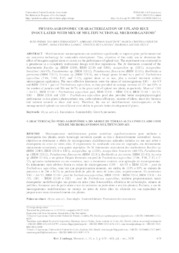Physio-agronomic characterization of upland rice inoculated with mix of multifunctional microorganisms.
Physio-agronomic characterization of upland rice inoculated with mix of multifunctional microorganisms.
Author(s): FERNANDES, J. P. T.; NASCENTE, A. S.; FILIPPI, M. C. C. de; LANNA, A. C.; SOUSA, V. S.; SILVA, M. A.
Summary: Multifunctional microorganisms can contribute significantly to improve plant performance and are innovative technology for sustainable development. Thus, objective of this study was to determine the effect of bioagents applied alone or in mix on the performance of upland rice. The experiment was conducted in a greenhouse in a completely randomized design with four replications. The 26 treatments consisted of the rhizobacteria Bacillus sp. (BRM 32109, BRM 32110 and 1301), Azospirillum sp. (1381), Azospirillum brasilense (Ab-V5), Pseudomonas sp. (BRM 32112), Pseudomonas fluorescens (BRM 32111), Burkholderia pyrrocinia (BRM 32113), Serratia sp. (BRM 32114), and a fungal genus formed by a pool of Trichoderma asperellum (T-06, T-09, T-12, and T-52), applied alone or in mix, plus a control treatment without microorganism application. The most effective treatments were the mixes of microorganisms 1301 + Ab-V5 and BRM 32114 + pool of Trichoderma asperellum, as they provided an average increase of 123 and 88% in the number of panicles and 206 and 167% in the grain yield of upland rice plants, respectively. Mixes of 1301 + Ab-V5, BRM 32114 + Trichoderma asperellum pool, BRM 32110 + BRM 32114, BRM 32110 + Ab-V5, 1301 + BRM 32110 and 1381 + Trichoderma asperellum pool also provided better morphophysiological performance in rice plants (photosynthetic rate, carboxylation efficiency, number of tillers, shoot dry biomass and nutrient content in shoot and root). Therefore, the use of multifunctional microorganisms in the management of upland rice was efficient in its ability to provide better development of plants.
Publication year: 2020
Types of publication: Journal article
Unit: Embrapa Rice & Beans
Observation
Some of Embrapa's publications are published as ePub files. To read them, use or download one of the following free software options to your computer or mobile device. Android: Google Play Books; IOS: iBooks; Windows and Linux: Calibre.
Access other publications
Access the Agricultural Research Database (BDPA) to consult Embrapa's full library collection and records.
Visit Embrapa Bookstore to purchase books and other publications sold by Embrapa.

